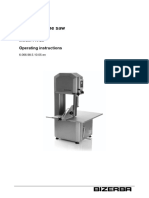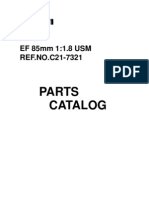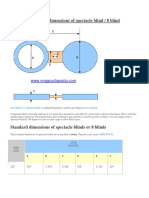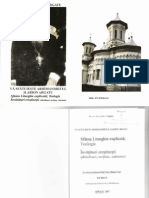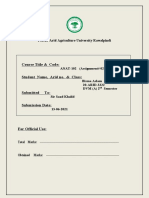Wavistrong Installation Manual Rubber Seal Lock Joint
Wavistrong Installation Manual Rubber Seal Lock Joint
Uploaded by
Violeta TaniCopyright:
Available Formats
Wavistrong Installation Manual Rubber Seal Lock Joint
Wavistrong Installation Manual Rubber Seal Lock Joint
Uploaded by
Violeta TaniCopyright
Available Formats
Share this document
Did you find this document useful?
Is this content inappropriate?
Copyright:
Available Formats
Wavistrong Installation Manual Rubber Seal Lock Joint
Wavistrong Installation Manual Rubber Seal Lock Joint
Uploaded by
Violeta TaniCopyright:
Available Formats
INSTALLATION MANUAL
Rubber Seal (Lock) Joint
Wavistrong ®
Installation Manual
Rubber Seal (Lock) Joint
REP 320/REV 02/0401RSLJ
Date of issue:
16-10-2006
Replaces issue:
Wavistrong Installation Manual Rubber Seal (Lock) Joint
-1-
All information was correct at the time of going to press. However, we reserve the right to alter, amend
and update any products, systems and services described in this brochure. We accept no responsibility
for the interpretations of statements made.
© Copyright by Future Pipe Industries B.V.
No part of this work may be reproduced in any form, by print, photo print, microfilm or any other
means without written permission from the publisher.
Wavistrong Installation Manual Rubber Seal (Lock) Joint
-2-
Table of Contents
1. Introduction 4
2. Integral Rubber Seal Joint (RSJ) and Rubber Seal Lock Joint (RSLJ) 5
2.1. Tools for rubber seal joints 5
2.2. Rubber Seal Joint 5
2.2.1. Rubber Seal Joint (RSJ) 5
2.2.2. Rubber Seal Lock Joint (RSLJ) 9
2.3. Dimensions of rubber ring and locking strip 12
2.4. Installation time for rubber seal joints 14
2.5. Disassembly of rubber seal joints 15
Wavistrong Installation Manual Rubber Seal (Lock) Joint
-3-
1. Introduction
This manual is written as a guide for supervisors and field engineers and explains the possibilities of
Wavistrong systems. In addition this manual provides guidance on how to avoid and solve problems
during installation.
Reinforced thermosetting resin pipe (R.T.R.P.) systems offer, by their specific nature, many applications
and advantages compared with other materials. In order to utilize all these properties it is essential, for
those who use Wavistrong material, carefully to observe these guidelines. Please note that these
instructions are for guidance only. Specifications written for a particular project will have priority.
Although the procedures written in this manual are as complete as possible, it is not possible to describe
all the different circumstances you may meet. For this reason our experienced supervisors may vary the
described procedures in order to achieve an optimum solution, using the latest installation techniques
and processing methods.
Wavistrong Installation Manual Rubber Seal (Lock) Joint
-4-
2. Integral Rubber Seal Joint (RSJ) and Rubber Seal Lock Joint (RSLJ)
Before assembling the Rubber Seal Joints, all safety precautions need to be checked. Ensure that all
necessary tools and materials are available.
2.1. Tools for rubber seal (lock) joints.
Rubber Seal Joints
For assembly of rubber seal joints the following is needed:
A Lubricant for O-ring and locking strip
B A rod or stick
C Two pipe clamps or slings
D Chain tackles (2): up to ID 500 mm pulling force 750 kg.
ID > 500 mm pulling force 1500 kg.
E Plastic or wooden mallet to drive the locking strip into the rubber seal lock joint
F Non-fluffy cleaning-rags
2.2 Installing Rubber Seal Joint (RSJ) and Rubber Seal Lock Joint (RSLJ)
2.2.1 Rubber Seal Joint (RSJ)
The following action must be taken in order to install the rubber seal joint.
- Clean the spigot and socket end thoroughly with a clean cloth before jointing.
Do not use material like dusters in order to avoid fibres from sticking to the surface of the seal.
- Check both pipe ends for any damage.
- Mark the depth of the entry on the spigot end (see Fig. 2.2.a.).
- For marking the depth of entry on the spigot end see Fig. 2.2.b..
- The location of the mark on the spigot end is given in Table 2.a.
- Position the rubber ring into the groove of the spigot end.
- Insert a round tool like a screwdriver underneath the rubber ring and work it around the pipe
a few times in order to distribute the tension (see Fig 2.2.c.).
free play
Fig. 2.2.a.
Wavistrong Installation Manual Rubber Seal (Lock) Joint
-5-
L mark
Fig. 2.2.b.
Table 2.a. The location of the mark on the RSJ spigot end
PN Angular
ID deflection
(mm) L mark
10 16 20 25 32
RSJ
bar bar bar bar bar
80 63 3°
100 63 3°
125 79 3°
150 78 3°
200 87 75 75 3°
250 118 117 117 3°
300 124 117 117 3°
350 127 117 117 3°
400 132 118 118 3°
450 137 137 139 139 3°
500 185 161 161 161 3°
600 195 161 161 161 2°
700 213 213 2°
750 213 213 2°
800 213 213 2°
900 233 2°
1000 233 2°
1200 294 1°
1400 273 1°
Wavistrong Installation Manual Rubber Seal (Lock) Joint
-6-
Fig. 2.2.c.
- Apply Future Pipe Industries lubricant to the rubber ring and the entire inner surface of the socket end.
- Avoid any lubricant under the rubber ring in order to prevent it from slipping out of the groove.
Do not try to assembly the joint without the use of any lubricant. The standard lubricant can cause
filters to block. Future Pipe Industries can supply lubricants that are soluble in water. Soft soap can
be used as an alternative for the lubricant.
- Fit the rubber lined clamps or slings on both sides of the joint (Fig. 2.2.d.)
Fig. 2.2.d.
- Ensure that the spigot end is positioned right in front of the socket end and that both sections are
fully aligned.
- Attach the chain tackles to the clamps on both sides of the pipes to be connected and ease the
spigot slowly and gradually into the socket until the mark is in line with the front of the socket end.
- If in doubt, check with a thin feeler gauge around the circumference, to confirm that the rubber ring
is correctly located in the right position in the groove.
Wavistrong Installation Manual Rubber Seal (Lock) Joint
-7-
Fig.2.2.e.
Note: The above mentioned clamps are available from Future Pipe Industries or can also be made by
the client according the Future Pipe Industries drawings.
Diameters up tot 300 mm can be installed without the use of tackles. Using a wooden beam as a lever
at the end of the pipe can do the force necessary to make the joint. Do not try to join two pipes at an
angle, as it is probable that the rubber ring may slip out of the groove. However, if necessary, and only
after assembly of the joint a permitted angle may be used (see Table 2.c.).
Do not use the maximum permitted angle where you anticipate soil settlement.
For RSJ systems an additional ‘free play’ of 30 mm is allowed for diameters up to 300 mm and 50 mm
for diameters 350 mm up to 1400 mm. This ‘free play’ allows for contraction as a result of pressure,
temperature changes and soil settlement and therefore should not be used in the installation
Wavistrong Installation Manual Rubber Seal (Lock) Joint
-8-
2.2.2. Rubber Seal Lock Joint (RSLJ)
The following action must be taken in order to install the rubber seal joint.
play play
Fig. 2.2.f.
- Clean the spigot and socket end thoroughly with a clean cloth before jointing.
Do not use material like dusters in order to avoid fibres from sticking to the surface of the seal.
- Check both pipe ends for any damage.
- Position the hole(s) so the locking strip(s) can be inserted easily.
- Mark the depth of entry on the spigot end.
- The location of the mark on the spigot end is in Table 2.b.
- Position the rubber ring into the groove of the spigot end.
- Insert a round tool like a screwdriver underneath the rubber ring and work it around the pipe a few
times in order to distribute the tension (see Fig 2.2.c.).
- Attach the chain tackles to the clamps on both sides of the pipe and ease the spigot end slowly and
gradually into the socket end until the rear stop of the spigot end is past the hole of the locking strip.
- Apply some lubricant on the first section of the locking strip.
- Insert the locking strip in such a way ensuring that the bevelled end rests against the inside of the
socket (see Fig 2.2.h.).
Wavistrong Installation Manual Rubber Seal (Lock) Joint
-9-
L mark L mark
Fig. 2.2.g.
Table 2.b. The location of the mark on the RSLJ spigot end
PN Angular
ID deflection
L mark
(mm)
8 12.5 16 20 25 32 RSLJ
b b b b b b
80 63 1°30’
100 63 63 1°30’
125 79 79 1°30’
150 78 78 78 1°30’
200 87 87 132 132 1°30’
250 118 118 118 197 197 1°30’
300 124 124 124 199 199 1°30’
350 127 127 127 197 197 1°30’
400 132 132 132 204 204 1°30’
450 137 137 137 227 227 1°30’
500 185 185 272 272 272 1°30’
600 195 195 276 276 276 1°30’
700 213 213 323 323 1°
750 213 213 323 323 1°
800 213 213 324 324 1°
900 233 233 1°
1000 233 233 1°
1200 294 294 1°
1400 273 1°
Wavistrong Installation Manual Rubber Seal (Lock) Joint
- 10 -
- With a plastic or wooden mallet tap the locking
strip home until it rests against the first part of
the strip.
- The end of the locking strip sticks out by
approx. 100 mm. This allows disassembly of
the newly assembled joints.
- Ensure that the stop of both the socket end and
the spigot end are in contact with the locking
strip and that the fully extended system is kept
in this position.
Note: At low temperatures a plastic locking strip may
become less flexible. In this case it is advisable
to heat the locking strip up to about 20° C.
Fig. 2.2.h.
Table 2.c. Admissible angular deflection
ID Play Angular Deflection
(mm) (mm) RSLJ RSJ
80 3 1°30’ 3°
100 3 1°30’ 3°
125 6 1°30’ 3°
150 6 1°30’ 3°
200 6 1°30’ 3°
250 8 1°30’ 3°
300 8 1°30’ 3°
350 12 1°30’ 3°
400 12 1°30’ 3°
450 12 1°30’ 3°
500 16 1°30’ 3°
600 16 1°30’ 2°
700 16 1° 2°
750 16 1° 2°
800 16 1° 2°
900 16 1° 2°
1000 16 1° 2°
1200 26 1° 1°
1400 26 1° 1°
Wavistrong Installation Manual Rubber Seal (Lock) Joint
- 11 -
2.3. Dimensions of the rubber ring and the locking strip
The commonly used rubber ring is made of NBR (Nitril Butadiene Rubber). Other types of rubber can be
supplied depending on the medium and/or the temperature.
The different types of rubber can be recognized by the following colour codes:
S – styrene butadiene rubber SBR Colour code: red spot
N – nitril butadiene rubber NBR Colour code: yellow spot
E – ethane propene terpolymer EPDM Colour code: blue spot
F – fluor elastomer FKM
H – hydrogenated nitril butadiene rubber H-NBR
Do
Dr
Fig. 2.3.a.
The dimensions Dr and Do are shown on the O-ring as well as the year and month of production
Table 2.d. O-ring dimensions
ID (mm) Dr (mm) Do (mm)
80 7 90
100 7 109
125 10 132
150 10 156
200 10 207
250 14 260
300 14 311
350 14 360
400 17 409
450 17 460
500 22 508
600 22 610
700 26 690
750 26 740
800 26 790
900 26 880
1000 26 980
1200 30 1120
1400 32 1370
Wavistrong Installation Manual Rubber Seal (Lock) Joint
- 12 -
H
B
Fig. 2.3.b.
Table 2.e. Locking strip dimensions
PN (bar)
ID (mm) Min. Max. H (mm) B (mm) Length (mm) Quantity
80 32 32 8 12 420 1
100 25 32 8 12 420 1
125 25 32 10 14 550 1
150 20 32 10 14 780 1
200 16 20 10 14 780 1
200 25 32 10 14 780 2
250 12.5 20 16 20 1330 1
250 25 32 16 20 1330 2
300 12.5 20 16 20 1330 1
300 25 32 16 20 1330 2
350 8 16 16 20 1330 1
350 20 25 16 20 1330 2
400 8 16 16 20 1700 1
400 20 25 16 20 1700 2
450 8 16 16 20 1700 1
450 20 25 16 20 1700 2
500 8 12.5 20 24 2260 1
500 16 25 20 24 2260 2
600 8 12.5 20 24 2260 1
600 16 25 20 24 2260 2
700 8 12.5 23 40 2885 1
700 16 20 23 40 2885 2
750 8 12.5 23 40 2885 1
750 16 20 23 40 2885 2
800 8 12.5 23 40 2885 1
800 16 20 23 40 2885 2
900 8 12.5 23 40 1765 2
1000 8 12.5 23 40 1765 2
1200 8 12.5 23 40 2260 2
1400 8 8 23 40 2385 2
Wavistrong Installation Manual Rubber Seal (Lock) Joint
- 13 -
2.4. Installation time for the rubber ring joints
Estimated installation times for the rubber ring joints on site are shown in table 2.f. and 2.g.
These estimated times are based on:
- Uninterrupted work.
- Enough space and an open trench for underground applications, etc.
- An installation crew of 3 persons (two in the trench, one outside).
- Excluding the handling of the pipe.
Table 2.f. Installation time
ID (mm) Time (min.)
80 5
100 5
125 5
150 5
200 10
250 15
For ID > 250 mm it has been taken into account that the pipe will be moved using the excavator.
Table 2.g. Installation time
Time for clamping
ID (mm) and assembly of
the joint (min.)
300 15
350 15
400 15
450 20
500 20
600 20
700 20
750 25
800 25
900 25
1000 30
1200 30
1400 30
Wavistrong Installation Manual Rubber Seal (Lock) Joint
- 14 -
2.5. Disassembly of rubber seal joints
In principal it is possible to take rubber seal joints apart within a short period after installation.
In practice the joint will be cut out due to the lack of space to pull the spigot out of the socket, unless it is
the last installed joint.
The dismantling procedure for a rubber seal lock joint is as follows:
- Push the pipe back into position to free up the locking strip if possible.
- Grip the locking strip with a pair of pliers or a plate clamp.
- Tap the pliers or use a crane to pull the plate clamp to remove the locking strip. (If the locking strip
jams, turn the pipe a little while pulling the strip.)
- Pull the spigot end out of the socket until the rubber ring is positioned at the insertion hole of the
locking strip.
- Pull the rubber ring through this hole, cut the rubber ring and remove the ring completely through
the hole.
- Now the joint can be released completely.
Fig.2.5.a.
Wavistrong Installation Manual Rubber Seal (Lock) Joint
- 15 -
www.futurepipe.com
You might also like
- Bobcat 864 G Series Parts Manual SN - 518911001 - AboveDocument395 pagesBobcat 864 G Series Parts Manual SN - 518911001 - AboveKelliMcNuttBrownNo ratings yet
- Bizerba FK 23Document46 pagesBizerba FK 23artmeatNo ratings yet
- Ly001-Let-Bon-Fial-0007Document59 pagesLy001-Let-Bon-Fial-0007yousab creator2No ratings yet
- Mitsubishi Electric Heat Pump Parts Outdoor MUZ-GE PDFDocument10 pagesMitsubishi Electric Heat Pump Parts Outdoor MUZ-GE PDFTony SavageNo ratings yet
- Diferencial Delantero 44 46000 RockwellDocument4 pagesDiferencial Delantero 44 46000 RockwellDaniel Marin MoralesNo ratings yet
- PJSUA2 DocDocument273 pagesPJSUA2 DocpruebaNo ratings yet
- Meat and Bone Saw: Spare Parts List No.: 067.98.3.1004Document20 pagesMeat and Bone Saw: Spare Parts List No.: 067.98.3.1004ivan boras100% (1)
- Electrolux - Masina Cuburi EngDocument12 pagesElectrolux - Masina Cuburi EngPaul MocanuNo ratings yet
- Direct Vent Gas Fireplace Heater Model SeriesDocument52 pagesDirect Vent Gas Fireplace Heater Model SeriesJames CloneyNo ratings yet
- Torque Ratings - G-Series (Pneumatic) : Spring-Return ActuatorsDocument54 pagesTorque Ratings - G-Series (Pneumatic) : Spring-Return ActuatorsYuri Soverika SitepuNo ratings yet
- Ef 85 1.8 UsmDocument5 pagesEf 85 1.8 UsmblarkarkNo ratings yet
- Kannad RC200Document20 pagesKannad RC200Jonathan HamillNo ratings yet
- Samsung La 22 26 32 C450e1 PDFDocument100 pagesSamsung La 22 26 32 C450e1 PDFadi0% (2)
- Exportlayers DWG ISO13567Document6 pagesExportlayers DWG ISO13567Naassom VazNo ratings yet
- Italian Fashion History of The 14th and 15th Century PDFDocument37 pagesItalian Fashion History of The 14th and 15th Century PDFAna Maria NegrilăNo ratings yet
- Shinmaywa User ManualDocument11 pagesShinmaywa User ManualYuswadi 3vkNo ratings yet
- DISSASEMBLY Travel Motor 1Document9 pagesDISSASEMBLY Travel Motor 1MoncefNo ratings yet
- Terra Grappler G2 All-Terrain Light Truck Radial Tires - Nitto TireDocument6 pagesTerra Grappler G2 All-Terrain Light Truck Radial Tires - Nitto TireABeery101_228907741No ratings yet
- Acme ALN 290 330 at 330 PiècesDocument8 pagesAcme ALN 290 330 at 330 Piècesrpicho100% (1)
- Midsection: Section 5 - Clamp and Swivel BracketDocument8 pagesMidsection: Section 5 - Clamp and Swivel BracketpedroNo ratings yet
- USQT.S739 Extinguishing System AttachmentsDocument3 pagesUSQT.S739 Extinguishing System AttachmentsMd.ShahabuddinNo ratings yet
- 167 Series IntensifiersDocument1 page167 Series IntensifiersLuis Eduardo Albarracin RugelesNo ratings yet
- Specification Manual For VGAN 1000Document22 pagesSpecification Manual For VGAN 1000kunjal_radiaNo ratings yet
- Sony Klv-26s400a Klv-32s400a Klv-37s400a Chassis Eg1l Ver.14Document72 pagesSony Klv-26s400a Klv-32s400a Klv-37s400a Chassis Eg1l Ver.14Jat ChamindaNo ratings yet
- International Standard: Agricultural Irrigation Equipment - Filters For Microirrigation - Granulated Media FiltersDocument8 pagesInternational Standard: Agricultural Irrigation Equipment - Filters For Microirrigation - Granulated Media FiltersBarun KumarNo ratings yet
- CA3000A Dodge BearingDocument708 pagesCA3000A Dodge BearingSuphi YükselNo ratings yet
- Pipe Dimensions - ASME B16-10Document1 pagePipe Dimensions - ASME B16-10Stin MorrisonNo ratings yet
- Just A Closer Walk With Thee: Grant Green VersionDocument2 pagesJust A Closer Walk With Thee: Grant Green VersionMichael Ferraro100% (1)
- Tech Data Sheet: Dual Shield Ii 101H4MDocument2 pagesTech Data Sheet: Dual Shield Ii 101H4McarlosNo ratings yet
- Rec Ncd6e 5640 PDFDocument7 pagesRec Ncd6e 5640 PDFOscar MolinaNo ratings yet
- Valve Positioner FK 41.82 (6) GB: Primary CharacteristicsDocument4 pagesValve Positioner FK 41.82 (6) GB: Primary CharacteristicsNguyen Kha100% (1)
- Parts List 09 128 02 06: AC Brake Motors BE05/BE1 - DR80 Brake, Additional ListDocument2 pagesParts List 09 128 02 06: AC Brake Motors BE05/BE1 - DR80 Brake, Additional ListApinat ChaisriNo ratings yet
- Hdx55a4 44S Servo Motor Hauser ManualDocument5 pagesHdx55a4 44S Servo Motor Hauser ManualVOLTA PRONo ratings yet
- Schiavi Enc Met Page024Document1 pageSchiavi Enc Met Page024Adel AdelNo ratings yet
- N° Codice / Code Descrizione Description Q.tà: VERSION 07/2012 From Serial 476Document3 pagesN° Codice / Code Descrizione Description Q.tà: VERSION 07/2012 From Serial 476Ahmad ShaheenNo ratings yet
- 118914-HDS-NT Mecha Ope Us-E04-201108Document198 pages118914-HDS-NT Mecha Ope Us-E04-201108jturnerNo ratings yet
- Tork Sikistirma DetaylariDocument37 pagesTork Sikistirma DetaylariErhan TolNo ratings yet
- Yk-Xe Inst e v1.32Document174 pagesYk-Xe Inst e v1.32Phạm BìnhNo ratings yet
- Panasonic Pcz1104070ce Tx-P42st30e tx-p42st30j tx-pf42st30 tx-pr42st30 Chassis Gpf14d-EDocument138 pagesPanasonic Pcz1104070ce Tx-P42st30e tx-p42st30j tx-pf42st30 tx-pr42st30 Chassis Gpf14d-EnovyNo ratings yet
- Firsa Catalog 2009Document53 pagesFirsa Catalog 2009alankar2050No ratings yet
- Fxcv-72N: Glass and DishwashersDocument22 pagesFxcv-72N: Glass and DishwashersAugusto Moises100% (1)
- Installation, Operation, and Maintenance: Enertech Hemi Cartridge Valve (HCV) ManualDocument4 pagesInstallation, Operation, and Maintenance: Enertech Hemi Cartridge Valve (HCV) Manualshubham100% (1)
- Standard Dimensions of Spectacle Blind ThicknessDocument10 pagesStandard Dimensions of Spectacle Blind ThicknessSubrata MukherjeeNo ratings yet
- Sr90 StandardDocument26 pagesSr90 Standardflorin74No ratings yet
- Panasonic DVD Sa-Vk450eeDocument126 pagesPanasonic DVD Sa-Vk450eefunpinochio0% (1)
- Black & Galvanized Steel Pipe BS 1387-1985 Size68 - 7kDocument1 pageBlack & Galvanized Steel Pipe BS 1387-1985 Size68 - 7kวิทวัส นิเทียนNo ratings yet
- Dual Actuator Mechanical InstallationDocument28 pagesDual Actuator Mechanical InstallationZhang801No ratings yet
- Pioneer vsx-524-k vsx-5241 Av Receiver rrv4533 Parts SMDocument4 pagesPioneer vsx-524-k vsx-5241 Av Receiver rrv4533 Parts SMImraan Ramdjan50% (2)
- HOBART AIRFORCE 250 t928 - HobDocument60 pagesHOBART AIRFORCE 250 t928 - HobRoberto MoctezumaNo ratings yet
- Three-Plates Mold Usage Example of MISUMI Standard ComponentsDocument1 pageThree-Plates Mold Usage Example of MISUMI Standard ComponentsOrc OrcNo ratings yet
- (123doc) Bang Tra Thong So Duong Day Va Tba Trong He Thong DienDocument2 pages(123doc) Bang Tra Thong So Duong Day Va Tba Trong He Thong DienLê Phước HoàngNo ratings yet
- G25M R TransmissionDocument29 pagesG25M R TransmissionMaksym VovkNo ratings yet
- En - Steval-Iss001v2 Bom PDFDocument5 pagesEn - Steval-Iss001v2 Bom PDFaducbkfetNo ratings yet
- PC9727 JD6090HF475 Parts Manual PDFDocument15 pagesPC9727 JD6090HF475 Parts Manual PDFmuahdibNo ratings yet
- Section 4 - PowerheadDocument53 pagesSection 4 - PowerheadpedroNo ratings yet
- Johnson Screens Nozzles PDFDocument2 pagesJohnson Screens Nozzles PDFVICTORNo ratings yet
- Wear Ring - WrpagfDocument6 pagesWear Ring - Wrpagfsaurabhbit19No ratings yet
- Fine Hammer Breaker ManualDocument186 pagesFine Hammer Breaker ManualMohamed AttiaNo ratings yet
- Installation Instructions: Alignment, Sleeve Seating and Torque Wrench Use Are Critical To Coupling OperationDocument2 pagesInstallation Instructions: Alignment, Sleeve Seating and Torque Wrench Use Are Critical To Coupling OperationcakendriNo ratings yet
- Parts Service Operation: Introduction of Kit of O-Ring Which Komatsu Logo & Parts Number Is Printed For Hose ExchangeDocument2 pagesParts Service Operation: Introduction of Kit of O-Ring Which Komatsu Logo & Parts Number Is Printed For Hose ExchangeNaughty VongNo ratings yet
- A747-2518-MECH-082 - Rev-00 - APPROVED BElt SCHDocument4 pagesA747-2518-MECH-082 - Rev-00 - APPROVED BElt SCHhapp_dentNo ratings yet
- Pulleys TechDocument8 pagesPulleys TechashkansoheylNo ratings yet
- Rotork ManualDocument20 pagesRotork ManualScotchWhisky82100% (1)
- Index Today (%) 1 Week (%) 1 Month (%) 6 Months (%) 1 Year (%) YTD (%)Document11 pagesIndex Today (%) 1 Week (%) 1 Month (%) 6 Months (%) 1 Year (%) YTD (%)Violeta TaniNo ratings yet
- I&cDocument14 pagesI&cVioleta TaniNo ratings yet
- Strenght Calculation For ThermowellsDocument4 pagesStrenght Calculation For ThermowellsVioleta TaniNo ratings yet
- Bom Code Breakdown Rev1Document1 pageBom Code Breakdown Rev1Violeta TaniNo ratings yet
- Eilat: Archaeology and History in The RegionDocument33 pagesEilat: Archaeology and History in The RegionVioleta TaniNo ratings yet
- Tube Fittings PDFDocument108 pagesTube Fittings PDFVioleta TaniNo ratings yet
- Basilica of The Holy BloodDocument13 pagesBasilica of The Holy BloodVioleta TaniNo ratings yet
- Ilarion Argatu - Sfanta Liturghie ExplicataDocument92 pagesIlarion Argatu - Sfanta Liturghie Explicatascribdeugen86% (7)
- CESO Application For AssistanceDocument11 pagesCESO Application For AssistanceDarren GuzagoNo ratings yet
- SM 1 PDFDocument148 pagesSM 1 PDFAkash JainNo ratings yet
- Grammar in ESLDocument262 pagesGrammar in ESLKavita Vitz100% (1)
- Pressure Vs StressDocument2 pagesPressure Vs StressMustapha SedikNo ratings yet
- KV-N60AR DatasheetDocument4 pagesKV-N60AR Datasheetasrulnizam matnorNo ratings yet
- SurinameDocument9 pagesSurinameReza Pall MallNo ratings yet
- Working Load Limit Defined and Replaces Safe Working Load TerminologyDocument2 pagesWorking Load Limit Defined and Replaces Safe Working Load TerminologyAnonymous 48jYxR1CNo ratings yet
- Drug CharterDocument13 pagesDrug Chartermadhuprasad.sgNo ratings yet
- 4# Bisma Aslam (20-ARID-3222)Document8 pages4# Bisma Aslam (20-ARID-3222)TasbihaNo ratings yet
- 3 Core Lesson PLan Based On MI (VARK)Document8 pages3 Core Lesson PLan Based On MI (VARK)prasannamentel100% (2)
- Unit 5 Financial AdministrationDocument19 pagesUnit 5 Financial AdministrationSharmila ShankarNo ratings yet
- Laking-European Armour and Arms Vol 3Document408 pagesLaking-European Armour and Arms Vol 3RonLayton100% (1)
- Research On The Advantages and Disadvantages of Tesla's Supply Chain in ChinaDocument5 pagesResearch On The Advantages and Disadvantages of Tesla's Supply Chain in ChinaAchmad Dhani MaulanaNo ratings yet
- Myosin Powered Cell Movements-GopalDocument15 pagesMyosin Powered Cell Movements-GopalAnonymous 3JjIwLeNo ratings yet
- Opel Blink CodesDocument9 pagesOpel Blink CodesBabei Ionut-MihaiNo ratings yet
- Aoc Lc32k0d3d Lc42k0d3dDocument116 pagesAoc Lc32k0d3d Lc42k0d3dmarcellobbNo ratings yet
- Concepts in Enterprise Resource Planning: Chapter Seven Process Modeling, Process Improvement, and ERP ImplementationDocument30 pagesConcepts in Enterprise Resource Planning: Chapter Seven Process Modeling, Process Improvement, and ERP ImplementationsiddeshgoregaonkarNo ratings yet
- Cambridge Assessment International Education: Business Studies 0450/23 May/June 2018Document13 pagesCambridge Assessment International Education: Business Studies 0450/23 May/June 2018Ayesha JagotNo ratings yet
- NDT Module 1Document23 pagesNDT Module 1Sajeesh Saji100% (1)
- Battery Sizing - Open ElectricalDocument10 pagesBattery Sizing - Open ElectricalSAINo ratings yet
- Ammayapper Textiles Private Limited: Rating AdvisoryDocument6 pagesAmmayapper Textiles Private Limited: Rating AdvisoryGayathriNo ratings yet
- IMA 24549 CMA Exam Questions Low Res PDFDocument20 pagesIMA 24549 CMA Exam Questions Low Res PDFIjup Cupida100% (1)
- Fundamental of BankingDocument55 pagesFundamental of BankingSubodh RoyNo ratings yet
- ECIL Trade Apprentice Recruitment 2024 NotificationDocument5 pagesECIL Trade Apprentice Recruitment 2024 NotificationmanjunathbandlapalliNo ratings yet
- VenturimeterDocument45 pagesVenturimetersulakshna kiranNo ratings yet
- Capital Structure DecisionDocument26 pagesCapital Structure DecisionNet BeeNo ratings yet
- Nissan Murano Z50 2002-2008 MaintenanceDocument34 pagesNissan Murano Z50 2002-2008 MaintenancejuanNo ratings yet
- Chap 4 Molecular Velocity DistributionDocument22 pagesChap 4 Molecular Velocity Distribution李侑霖 LEE YULIN P46094163No ratings yet

